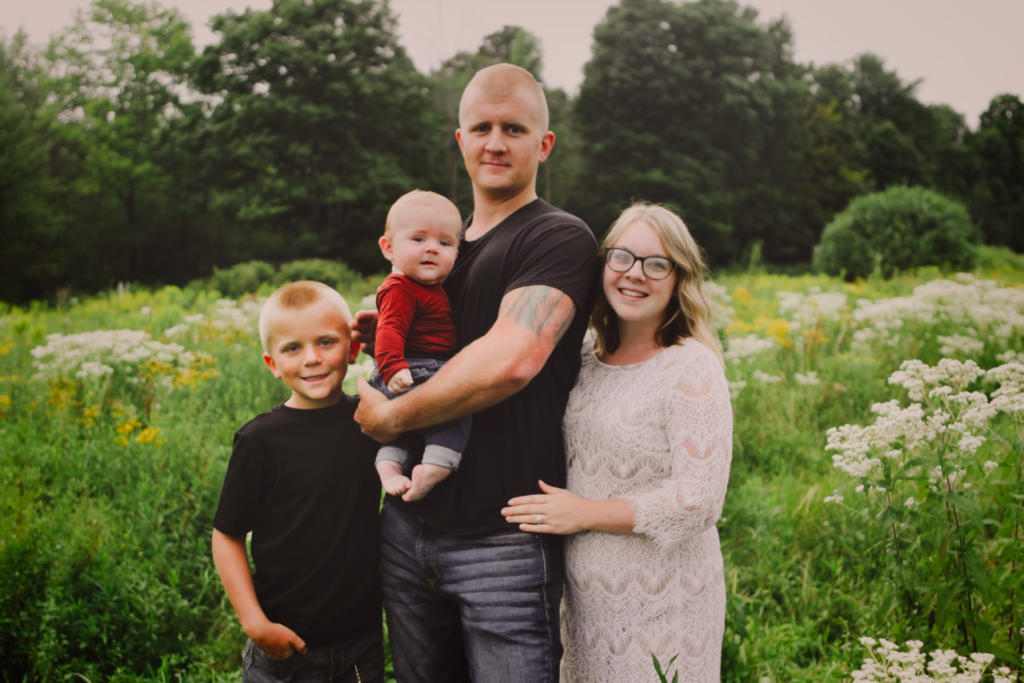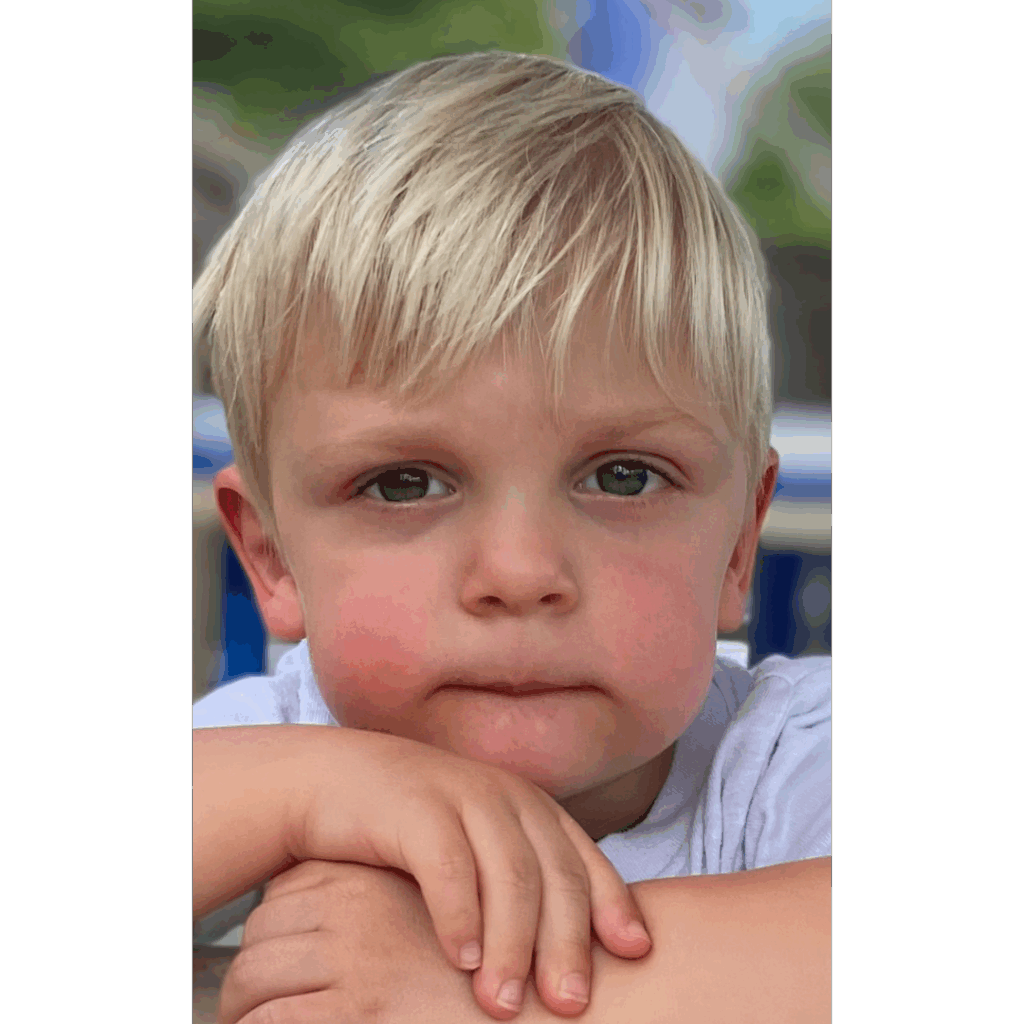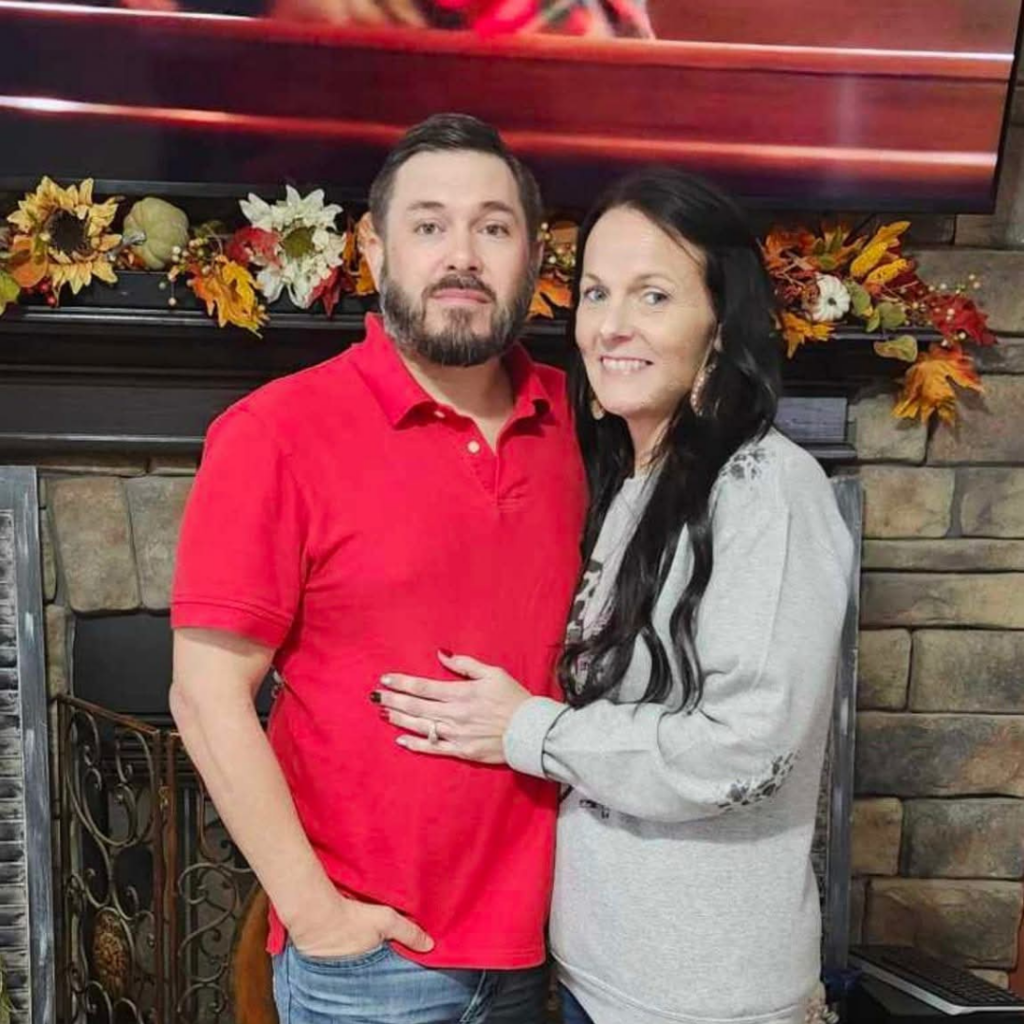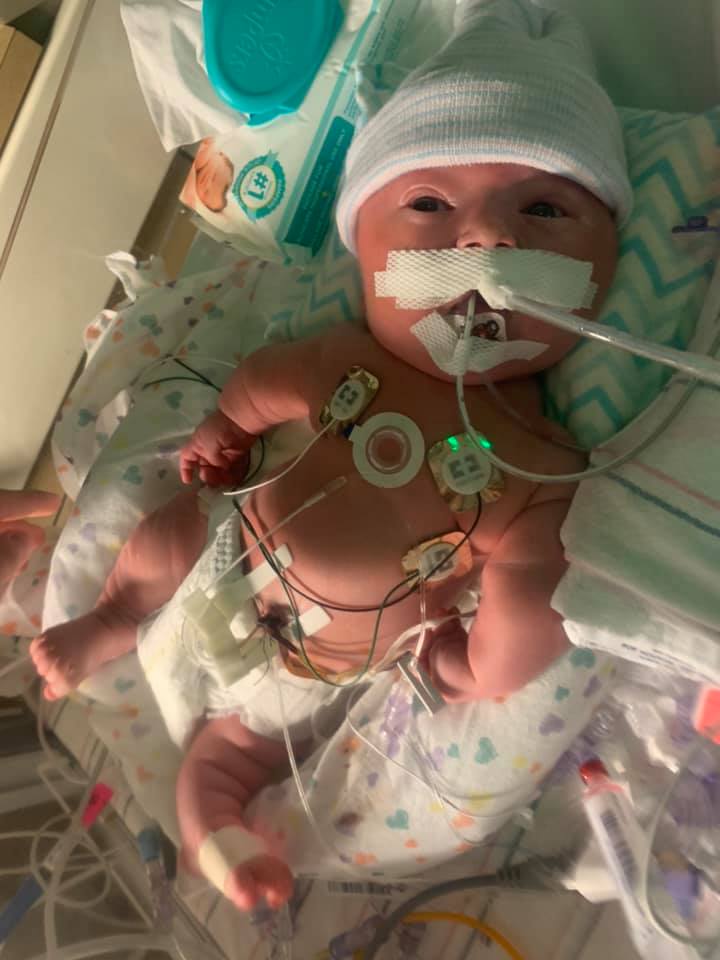Laiken, Rowan and their Family’s HPP Journey

At fifteen weeks pregnant my husband and I decided to have an elective ultrasound performed for gender confirmation at our local OB/GYN office in Jamestown, NY. We had the ultrasound completed on a Saturday – due to an inconclusive result, I was asked to return to the office that following Monday for a repeat scan. I left work on my lunch break, anticipating a quick five-minute scan, and gender confirmation of my sweet baby. My “five-minute scan” soon became a fifteen-to-twenty minute scan. The technician informed me at that time that she was having difficulties locating Rowan’s lower extremities (any abnormality is a mandatory report to NYS). She then obtained measurements of both of Rowan’s arm, his stomach/trunk, and what parts of the legs that she could locate. Every measurement was different. At this point, I was sent upstairs to the main office to meet with one of the Midwives.
The first step in identifying the causation for Rowan’s abnormalities was completion of an NIPT test and a referral to a specialist in Buffalo, NY. The NIPT test was negative for any abnormalities. My appointment in Buffalo wasn’t for another five weeks, landing me at twenty-weeks pregnant come the time of the appointment; it was an agonizing five-week wait. My husband and I went into the appointment not knowing what to expect; planning for the worst but hoping for the best. The technician spent approximately half-an-hour obtaining a comprehensive anatomy scan; then we saw the doctor. We were sat at a round table in one of the consult rooms; my husband and I on one side of the table and the doctor and his resident on the other side. At this time the results of Rowan’s anatomy scan were explained to us – overall, none of his extremities were measuring appropriately for his gestational age, each extremity measured at a different gestational age, and all of his long bones were shortened and curved. I remember the doctor saying, “I’m so sorry… I’m so sorry…” He suspected that Rowan may have Campomelic Dysplasia, a lethal type of skeletal dysplasia.
We were told that our baby would likely be “incompatible with life” and were instructed to weigh our options: continue the pregnancy or terminate. No words will ever be able to articulate how we felt that day – anger, hurt, and devastation only skim the surface of the gut-wrenching emotions that we were feeling. I returned to the office a week later for an amniocentesis in order to confirm Rowan’s official diagnosis; at this time a sample of my bloodwork was also obtained for sampling, per the request of the specialty lab receiving the amniocentesis sample. We continued to receive follow-up appointments once a week. At twenty-three weeks pregnant, we received Rowan’s amniocentesis results, confirming the diagnosis of Hypophosphatasia (HPP). Rowan inherited HPP recessively from both my husband and I. We were once again informed that while the diagnosis is not as lethal as Campomelic Dysplasia, that there was still a lethal risk; we left that appointment being told that we had one week to decide whether or not we wanted to continue the pregnancy or terminate (NYS allows termination of pregnancy only up to twenty-four weeks). Not knowing anything about the diagnosis and with only minimal, outdated research, we decided to continue the pregnancy. We followed-up with our doctor every two weeks, collecting measurements of Rowan’s upper and lower extremities, head, stomach, and chest cavity at every visit. While Rowan’s extremities never measured “normal” or comparable to his gestational age, they did measure longer than each subsequent visit indicating some bone growth. Rowan’s long bones maintained both shortened and curved. His chest cavity measured and presented normal throughout the duration of our pregnancy – this felt like our saving grace. As always, every visit ended with the reminder that “this diagnosis could still be lethal.”
Rowan was born at thirty-five weeks gestation when I went into pre-term labor. He was delivered via cesarean section due to his breech positioning. Upon delivery Rowan was transferred to the Neonatal Intensive Care Unit (NICU) where he spent fifteen days. Rowan required oxygen via nasal cannula only twice while in the NICU. He spent his first two days of life in a head and neck immobilizer as there was concern of the mineralization (or potential lack thereof) of his cervical vertebrae; after a complete skeletal survey, it was determined that Rowan’s cervical spine was normal. Rowan had consults completed by every discipline in order to obtain baseline assessments: neurology, neurosurgery, pulmonology, orthopedic, endocrinology, genetics, urology, nephrology, ophthalmology, PT/OT, and cardiology.
Rowan was started on StrensiqTM on February 28th, the day after he was born. Since being discharged home from the NICU, Rowan has continued to follow-up with many specialties. We most frequently follow-up Endocrinology and Nephrology, however, other disciplines we see are: neurology, ophthalmology, developmental clinic, and pulmonology. Rowan has OT in-home twice a week; he has limited mobility in his left-ankle (limited dorsiflexion) which will pose challenges once Rowan starts walking.
He receives StrensiqTM three time per week at home, along with Vitamin D. Rowan’s urine calcium level finally became normal at six-months old. We are currently following with Endocrine and Nephrology every three months where Rowan receives repeat blood work, a urine sample, a skeletal survey, and an ultrasound of the kidneys.
What kind of specialist made the HPP diagnosis? How long did it take? At what age was the diagnosis made?
A maternal-fetal medicine specialist made Rowan’s HPP diagnosis after completion of an amniocentesis. From the time the amniocentesis sample was collected to the time of diagnosis, it took three weeks. Rowan was 24-weeks gestation when we received his official diagnosis.
How did you feel when you were first diagnosed with HPP?
When Rowan was first diagnosed with HPP we felt relief – relief in that this diagnosis was less lethal than the diagnosis we were previously given. However, feelings of anxiousness, sadness, and grief continued to ensue. My husband and I didn’t have the slightest idea of what to expect with this diagnosis as the severity varies from person-to-person. We were hopeful for a miracle, but the feeling of the unknown left us feeling unsettled more often than not.
Tell us about yourself. Where are you from? What are your hobbies?
We are a family of four from New York State. We have two dogs and as a family enjoy going on walks, specifically walking the beach to collect beach glass and skip rocks.
What is your advice to someone who is newly diagnosed? What do you wish someone had told you?
My advice to someone who is newly diagnosed with an affected child in-utero is to just breathe. I would tell them to do everything in their power to not stress (knowing that is easier said than done). I would advise that they take everything in strides; appointment by appointment, and not get ahead of themselves. I would tell them to celebrate EVERY small win – when your world feels like its crumbling in on you, it’s the small things that count. I wish someone would have told me that it will all be okay, no matter what happens. I wish someone would have told me to look for a community of people to share my experience with and gain support from, like SoftBones.
What is your hope for the HPP community?
My hope for the HPP community is that the knowledge in/of it continues to grow and flourish for everyone affected with or caring for someone affected with HPP. I hope that someday we can find a more sustainable route of medication administration so that babies like mine don’t have to receive lifelong injection therapy, three times a week. I hope that as knowledge of HPP increases, the education increases and becomes more updated. In doing so, those affected with HPP will be more apt to receive an early diagnosis and therefore will suffer less adverse effects of the diagnosis.
Name a success you have had during your HPP journey. What challenges have you overcome? What are your goals now?
The success that we have had during Rowan’s HPP journey has been the proactive care that we have received; through medication therapy Rowan’s bones have been growing longer and mineralizing and his labs are normalizing. Through OT, Rowan has been keeping on track developmentally.
Our goals are to continue to working on gross motor skills (crawling and standing) and addressing the limited mobility in Rowan’s left ankle in preparation for walking.







Responses